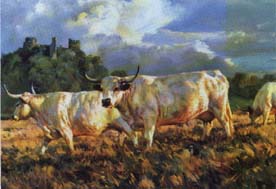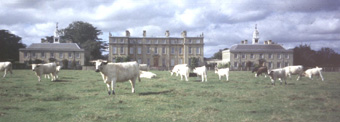WHITE PARK CATTLE are the most ancient native breed of the British Isles and an integral part of our heritage
THIS PAGE:
- White Park history; British Isles and abroad; published history
- White Park qualities; local adaptation, conservation grazing; quality beef
- Herd improvement; improving White Park cattle; advisory services
- White Park history; British Isles and abroad; published history
- White Park qualities; local adaptation, conservation grazing; quality beef
- Herd improvement; improving White Park cattle; advisory services
History
The origins of the White Park are rooted in British history more deeply than any other breed of cattle. The first known references to white cattle as a special type are found in Ireland, and occur in place names such as Inishbofin (island of the white cow) off the coast of Connemara. They are an integral part of Irish saga and legends dating back as far as the first millennium BC when Queen Maeb of Connacht invaded Ulster because of Finnbennach, the white horned bull owned by her husband. More recent research has traced the ancestry of a Dynevor family to a cow in the Middle East 10,000 years ago.
They also played a significant role in Welsh history. Wales was th e final refuge of the Druids retreating from Roman persecution, and they used white cattle for sacrifice. The cattle are recorded specifically in 856 AD when Rhodri Fawr established Dynevwr (also known as Dynevor) as the seat of political power in the kingdom of Deheubarth, and this was the foundation of the Dynevor herd. Rhodri's grandson, Hywel Dda, formulated the famous codes of legislation in which the white cattle assume a special status as currency in the payment of fines.
e final refuge of the Druids retreating from Roman persecution, and they used white cattle for sacrifice. The cattle are recorded specifically in 856 AD when Rhodri Fawr established Dynevwr (also known as Dynevor) as the seat of political power in the kingdom of Deheubarth, and this was the foundation of the Dynevor herd. Rhodri's grandson, Hywel Dda, formulated the famous codes of legislation in which the white cattle assume a special status as currency in the payment of fines.
Cattle at Dynevwr by Donald Grant © CLL
Herds were established in England and Scotland in the thirteenth century when the Charta Forestae (1225) allowed forests and hunting chases to be emparked. The Blair Atholl, Cadzow, Cumbernauld and Drumlanrig herds in Scotland, and the Barnard Castle, Bishop Auckland, Chartley, Chillingham, Hoghton Tower and Lyme Park herds in England were formed in this way. The Cadzow and Chartley herds continue to be registered in the herd book.
Although White Park cattle can be kept in intensive systems, it is not their natural environment. They show to best advantage where their hardy thriftiness and preference for coarse herbage can be exploited in extensive low-input systems of management for commercial production, or in parkland surrounding stately homes where their distinctive appearance can be fully appreciated.
White Park cattle have been exported to several countries. Churchill considered them an important part of the British heritage and sent a group to Canada at the beginning of WW2 to protect them. They now are found in UK, Ireland, Canada, USA, Australia, New Zealand and Germany.
The full history of the breed (3rd edition), 'Breeding the Best', was written in 2019 (see 'Books' page).
Qualities .
The White Park has avoided selection pressures which have had a detrimental effect on many breeds in the last 100-200 years, and thus has retained its essential and distinctive qualities, especially -
~ Local adaptation and grazing behaviour is eminently suited to conservation grazing in a wide range of habitats from heath to wetlands and woodland to parkland. White Park cattle often show a preference for coarser herbage.
~ Thrifty efficiency in low-input extensive systems (see 'White Park; Dynevor' page) enables high quality beef to be produced from upland pastures. Although intensively-fed individual animals can attain weights of more than 900 kg at less than 2 years of age, the usual target at 3 years is a carcase of 350 kg from non-intensive management.
~ The superlative quality of its beef was recognised in perpetuity in the summer of 1617 when James 1, after a day of hunting, so enjoyed the beef from the resident herd at a banquet at Hoghton Tower in Lancashire that he dubbed it 'Sir Loin'. Its marbling and full flavour give it pride of place for discerning gourmets.
Herd Improvement
They also played a significant role in Welsh history. Wales was th
Cattle at Dynevwr by Donald Grant © CLL
Herds were established in England and Scotland in the thirteenth century when the Charta Forestae (1225) allowed forests and hunting chases to be emparked. The Blair Atholl, Cadzow, Cumbernauld and Drumlanrig herds in Scotland, and the Barnard Castle, Bishop Auckland, Chartley, Chillingham, Hoghton Tower and Lyme Park herds in England were formed in this way. The Cadzow and Chartley herds continue to be registered in the herd book.
Although White Park cattle can be kept in intensive systems, it is not their natural environment. They show to best advantage where their hardy thriftiness and preference for coarse herbage can be exploited in extensive low-input systems of management for commercial production, or in parkland surrounding stately homes where their distinctive appearance can be fully appreciated.
White Park cattle have been exported to several countries. Churchill considered them an important part of the British heritage and sent a group to Canada at the beginning of WW2 to protect them. They now are found in UK, Ireland, Canada, USA, Australia, New Zealand and Germany.
The full history of the breed (3rd edition), 'Breeding the Best', was written in 2019 (see 'Books' page).
Qualities .
The White Park has avoided selection pressures which have had a detrimental effect on many breeds in the last 100-200 years, and thus has retained its essential and distinctive qualities, especially -
~ Local adaptation and grazing behaviour is eminently suited to conservation grazing in a wide range of habitats from heath to wetlands and woodland to parkland. White Park cattle often show a preference for coarser herbage.
~ Thrifty efficiency in low-input extensive systems (see 'White Park; Dynevor' page) enables high quality beef to be produced from upland pastures. Although intensively-fed individual animals can attain weights of more than 900 kg at less than 2 years of age, the usual target at 3 years is a carcase of 350 kg from non-intensive management.
~ The superlative quality of its beef was recognised in perpetuity in the summer of 1617 when James 1, after a day of hunting, so enjoyed the beef from the resident herd at a banquet at Hoghton Tower in Lancashire that he dubbed it 'Sir Loin'. Its marbling and full flavour give it pride of place for discerning gourmets.
Herd Improvement
BREED BETTER CATTLE
My herd (Dynevor) of White Park cattle is the senior herd in the breed, and my experience in the development of breeding programmes is available to other breeders who are interested to investigate the merits of linebreeding, breeding objectives and trait evaluation. The quality of bulls is improved by an inspection procedure at 2 years of age which includes visual inspection by a senior inspector, linear assessment to predict the mature type of each bull, and an evaluation of pedigree. Their parentage is verified by DNA testing. Only the best sires and dams should be identified as potential parents of bulls.
I am available to give advice on any breeding or selection questions that other breeders or potential breeders may have.
Below right: Distinctive dominant White Park colour markings © CLL
Below: A White Park herd at a stately home © CLL